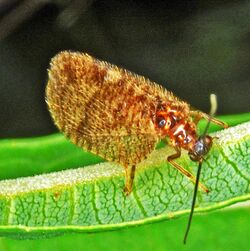Biology:Megalomus tortricoides
| Megalomus tortricoides | |
|---|---|

| |
| Megalomus tortricoides (cf.). | |
| Scientific classification | |
| Domain: | Eukaryota |
| Kingdom: | Animalia |
| Phylum: | Arthropoda |
| Class: | Insecta |
| Order: | Neuroptera |
| Family: | Hemerobiidae |
| Genus: | Megalomus |
| Species: | M. tortricoides
|
| Binomial name | |
| Megalomus tortricoides Rambur, 1842
| |
| Synonyms[1] | |
| |
Megalomus tortricoides is a species of brown lacewing in the family Hemerobiidae. It was first described by Rambur in 1842.[2]
Distribution
This species is widespread in central and southern Europe.[3] It is not present in the United Kingdom.
Habitat
These lacewings almost exclusively inhabit broad-leaved trees, especially Crataegus, Prunus and Berberis,[4] but they can also be found in xerothermic forest edges with pines.[5] They are present from sea level to mountain level.[4]
Description
Megalomus tortricoides can reach a body length of approximately 5–7 millimetres (0.20–0.28 in), with a wingspan of 16–21 millimetres (0.63–0.83 in).[4][5] In Megalomus tortricoides the head and the body are glossy, black or brown black. Antennae are mostly dark brown. The membrane of the forewings is distinctly spotted, a recurrent vein is present and the radial sector shows at least five ribs. Forewings have two fully formed rows of transverse rows.[6]
This species is very similar to Megalomus hirtus, which is slightly smaller and shows a maculation of the front and back wings darker and more contrasted. The females can be separated only on the basis of tiny differences. In general these two species can only be distinguished on the basis of the shape of the 10th tergite of the males. In fact the tip of the abdomen of males have a dorsal hump on the ectoproct.[5][6][7][8]
Biology
Adults are in flight between April and October (these insects partly overwinter).[4][5] Like their relatives, they are predominantly twilight and nocturnal. Adults mainly feed on aphids, tree sap and honeydew, where as larvae are active predators on aphids and bark lice.[5]
Bibliography
- Aspöck H., Aspöck U. & Hölzel H. (1980) - Die Neuropteres Europas – Goecke & Evers, Krefeld
- Oswald J.D. (2018). LDL Neuropterida Species of the World (version Jul 2018). In: Roskov Y., Ower G., Orrell T., Nicolson D., Bailly N., Kirk P.M., Bourgoin T., DeWalt R.E., Decock W., De Wever A., Nieukerken E. van, Zarucchi J., Penev L., eds. (2018).
References
| Wikimedia Commons has media related to Megalomus tortricoides. |
- ↑ Catalogue of life
- ↑ BioLib.cz
- ↑ Fauna Europaea
- ↑ 4.0 4.1 4.2 4.3 De Sancti Petri Fabrica per il riconoscimento dei Neuropterida adulti (specie) e stadi preimmaginali (quando va bene, generi, se non famiglie) dell’area geografica ± europea (in Italian)
- ↑ 5.0 5.1 5.2 5.3 5.4 Naturspaziergang (in German)
- ↑ 6.0 6.1 Keys of Neuropterida (in Italian)
- ↑ Aspöck H., Aspöck U. & Hölzel H. (1980) - Die Neuropteres Europas – Goecke & Evers, Krefeld
- ↑ Koen Lock Checklist of the Belgian Neuroptera
External links
- Entomologi Italiani (in Italian)
Wikidata ☰ Q7733646 entry
 |


